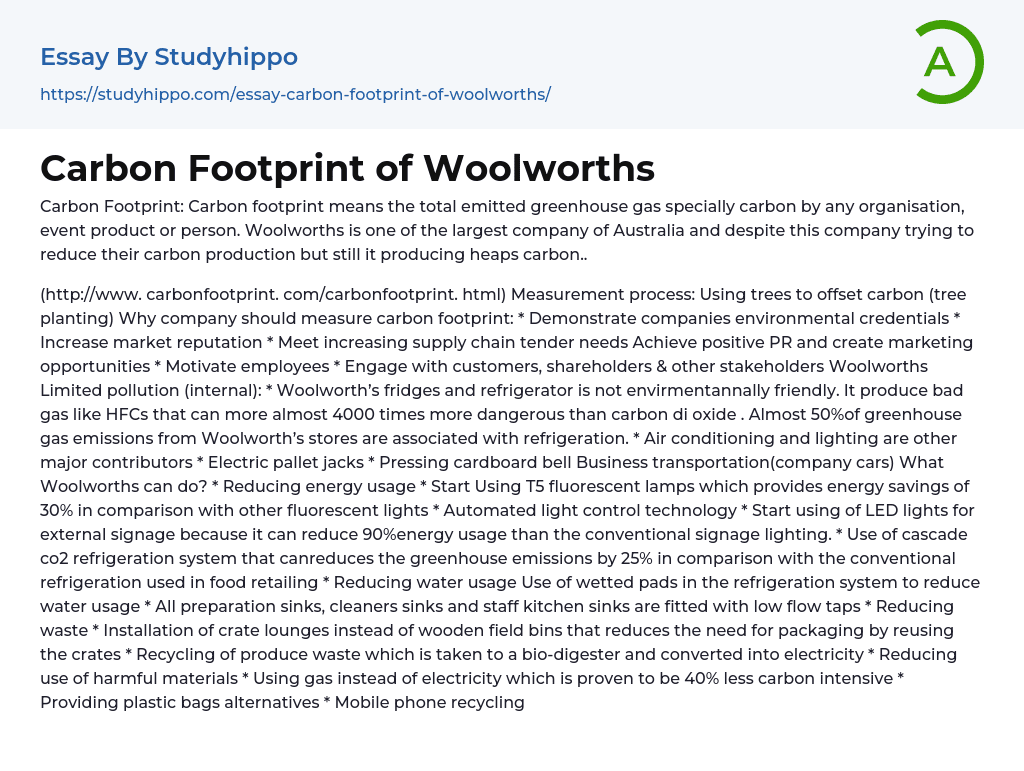Carbon Emission Impact: The concept of a carbon footprint pertains to the accumulative quantity of greenhouse gases, chiefly carbon, discharged by any enterprise, event, commodity, or person. As one of Australia's leading corporations, Woolworths is striving towards minimizing its carbon emission levels. Despite these efforts though, the company continues to generate a substantial measure of carbon.
Measurement Process: Using trees to balance carbon (tree planting). Reasons for businesses to calculate their carbon footprint include:
- Showcasing ecological credentials
- Boosting market reputation
- Fulfilling supply chain tender requirements while gaining favorable public relations and marketing possibilities
- Stimulating employees and interacting with clients, shareholders, and stakeholders
Woolworths Limited's internal pollution includes the following:
- Woolworth's cooling appliances are not eco-friendly as they emit detrimental gases like HFCs, which are nearly 4000 times more harmful than CO2. Around half of Woolworth's
... store-related greenhouse gas emissions come from refrigeration.
- Air conditioning and lighting also contribute considerably.
- Electric pallet jacks operations along with cardboard pressing
- Business transportation (company vehicles)
Suggested actions for Woolworths encompass:
- Overall reduction in energy consumption
- Adoption of T5 fluorescent lamps that offer 30% more energy efficiency compared to other fluorescent lights
- Application of automated light control technology
- Implementation of LED lights for outdoor signage, which can slash energy use by 90% relative to traditional sign lighting.
The text beneath emphasizes diverse sustainability practices within the food retail sector:
- The incorporation of a cascade CO2 refrigeration system trims down greenhouse emissions by 25% when contrasted with traditional cooling systems.
- Wetted pads have been integrated into the refrigeration system to cut back on water usage.- Water-saving low flow faucets are fitted in sinks at preparation areas, cleaning stations, and
staff kitchens to aid in water conservation.
- Instead of using wooden field bins, crate lounges are utilized which minimizes the requirement for packaging materials while encouraging reuse of crates.
- Leftover produce is repurposed through a bio-digester that transforms it into electricity.
- Gas usage has replaced electricity leading to a 40% drop in carbon intensity.
- Customers are provided with alternatives to plastic bags.
- The recycling of mobile phones is made possible and easier.
- Accounting essays
- Marketing essays
- Automation essays
- Business Cycle essays
- Business Model essays
- Business Operations essays
- Business Software essays
- Corporate Social Responsibility essays
- Infrastructure essays
- Logistics essays
- Manufacturing essays
- Multinational Corporation essays
- Richard Branson essays
- Small Business essays
- Cooperative essays
- Family Business essays
- Human Resource Management essays
- Sales essays
- Market essays
- Online Shopping essays
- Selling essays
- Strategy essays
- Management essays
- Franchising essays
- Quality Assurance essays
- Business Intelligence essays
- Corporation essays
- Stock essays
- Shopping Mall essays
- Harvard Business School essays
- Harvard university essays
- Trade Union essays
- Cooperation essays
- News Media essays
- Waste essays
- Andrew Carnegie essays
- Inventory essays
- Customer Relationship Management essays
- Structure essays
- Starting a Business essays
- Accounts Receivable essays
- Auditor's Report essays
- Balance Sheet essays
- Costs essays
- Financial Audit essays
- International Financial Reporting Standards essays
- Tax essays
- Accountability essays
- Cash essays
- Principal essays




